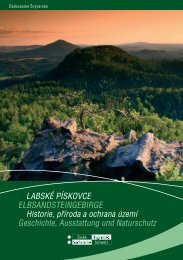ABSTRACT BOOK Sandstone Landscapes ... - Sandstones.org
ABSTRACT BOOK Sandstone Landscapes ... - Sandstones.org
ABSTRACT BOOK Sandstone Landscapes ... - Sandstones.org
Create successful ePaper yourself
Turn your PDF publications into a flip-book with our unique Google optimized e-Paper software.
PAriana Kulhánková, Ondřej Koukol and Jan MourekFaculty of Science, Charles University, Benátská 2, CZ-120 00 Praha 2, Czech Republic (Ondřej Koukol:bezlepka@natur.cuni.cz)Decomposition of litter in Pinus sylvestris and Pinus strobus forests in the Bohemian SwitzerlandNational ParkThe aim of the study was to evaluate:1/ Differences in the rate of needle litter decomposition of two pine species, autochtone Pinus sylvestris andnorthamerican Pinus strobus, in their forests on the tops of the sandstone rocks in Bohemian SwitzerlandNatonal Park. Litter-bag method was used during three years period; both kinds of litter were incubated inboth types of forests. 2/ Litter production, litter and superimposed humus physical properties and chemicalcomposition (nutrients, lignin and pH), ecological conditions (soil moisture and temperature) and standcharacteristics. 3/ Mycoflora (Ascomycetes) and Acarina (Oribatidae) colonisation of the pine needle litterin the process of decomposition.1/ Litter-decomposition of both litters was faster in Pinus strobus forest. It doesn´t depend on litter type,except for three months at the beginning of the decay. After three years, the decomposition approachedsimmilar rates in both forests and litters.2/ Pinus strobus litter fell earlier in the summer (june, july) comparating to Pinus sylvestris, burring herbsand tree seedlings. There were not important differences in litter chemical composition of both species andin humus from different forests. Net release of nitrogen began after 1.5 years of the exposition and is higherin Pinus sylvestris stand. Most of the ecological conditions diffeedr in Pinus strobus monoculturecomparing with forests of P. sylvestris and mixed forests, resulting in humus and nutrient accumulation andherb layer species decline.3/ 41 Ascomycetes species were determined on needle litter. 29 species colonized needles of both species,5 species were found only on P. strobus, 7 only on P. sylvestris. Three species were found as new for theCzech Republic: Tympanis neopythia, Septonema ochracea a Pseudocercospora deightonii.




